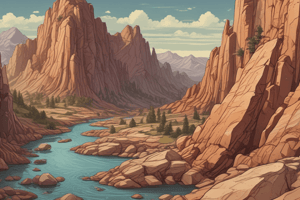Podcast
Questions and Answers
What type of rock formation results from the cooling of magma within the Earth's crust?
What type of rock formation results from the cooling of magma within the Earth's crust?
- Effusive volcanic
- Clastic
- Intrusive volcanic (correct)
- Metamorphic
Which of the following is a characteristic of sedimentary rocks?
Which of the following is a characteristic of sedimentary rocks?
- Contain large crystals due to slow cooling
- Result from the cooling of magma
- Formed under high pressure and temperature
- Often preserve fossils (correct)
What type of sedimentary rock is formed from the cementation of fragments of preexisting rocks?
What type of sedimentary rock is formed from the cementation of fragments of preexisting rocks?
- Intrusive
- Metamorphic
- Authigenic
- Clastic (correct)
Which of the following processes describes the formation of metamorphic rocks?
Which of the following processes describes the formation of metamorphic rocks?
How do colors in intrusive volcanic rocks like granite primarily vary?
How do colors in intrusive volcanic rocks like granite primarily vary?
What defines authigenic sedimentary rocks?
What defines authigenic sedimentary rocks?
Which of the following is NOT a type of sedimentary rock mentioned?
Which of the following is NOT a type of sedimentary rock mentioned?
What distinguishes effusive volcanic rocks from other types of igneous rocks?
What distinguishes effusive volcanic rocks from other types of igneous rocks?
Flashcards
What is a rock?
What is a rock?
A naturally occurring solid aggregate of minerals or mineraloids that forms a coherent whole.
What are igneous rocks?
What are igneous rocks?
Rocks formed from the cooling and solidification of magma or lava.
What are intrusive igneous rocks?
What are intrusive igneous rocks?
Igneous rocks formed when magma cools and solidifies slowly within the Earth's crust, allowing large crystals to grow.
What are extrusive igneous rocks?
What are extrusive igneous rocks?
Signup and view all the flashcards
What are metamorphic rocks?
What are metamorphic rocks?
Signup and view all the flashcards
What are sedimentary rocks?
What are sedimentary rocks?
Signup and view all the flashcards
What are clastic sedimentary rocks?
What are clastic sedimentary rocks?
Signup and view all the flashcards
What are authigenic sedimentary rocks?
What are authigenic sedimentary rocks?
Signup and view all the flashcards
Study Notes
Rocks and Fossils
- Rocks are natural aggregates of minerals or particles. They cannot be defined by their chemical formulas, but are well-defined in space.
- Crystalline Rocks (Igneous): Formed from cooling magma under high pressure.
- Intrusive: Magma cools slowly within the Earth's crust, creating large crystals (e.g., granite). Colors depend on the lava's composition.
- Effusive: Magma cools quickly, producing small crystals embedded in a non-crystalline matrix (e.g., porphyry). Colors depend on the lava's composition.
- Metamorphic Rocks: Pre-existing rocks transformed by high pressure and temperature (e.g., gneiss). This process is a slow, atom migration process.
- Sedimentary Rocks: Formed from the accumulation and cementation of particles.
- Clastic: Accumulation of fragments from other rocks (e.g., sandstones). Sandstones are composed of sand-sized grains (visible). Mudstones are composed of fine-grained clay (invisible). Conglomerates consist of gravel or pebble sized grains embedded in finer matrix.
- Authigenic: Particles that form in situ (in their location). Examples include limestones (calcite, aragonite, and other calcium carbonate crystals), which can have various colors, white is pure.
- These types may include coral reefs formed in open ocean settings.
Additional Information (from mixed rock types)
- Variations in color of rocks are influenced by the presence of different minerals, particularly iron or manganese. Gray/black coloration is linked to high organic matter content, while yellow, red, or brown hues indicate iron or manganese richness.
- Limestone, subjected to certain conditions, can change into dolostone (magnesium replaces limestone components).
- "Mixed" rocks result from the combination of autochthonous (formed in the same location) and exotic (imported) particles. For example, marls form in transitional areas like offshore shelf settings.
Studying That Suits You
Use AI to generate personalized quizzes and flashcards to suit your learning preferences.




